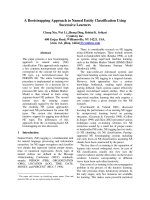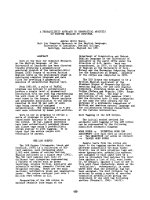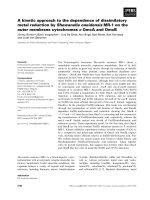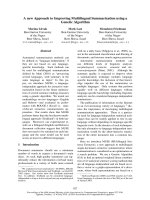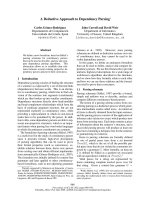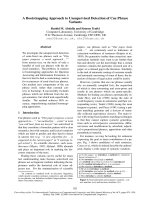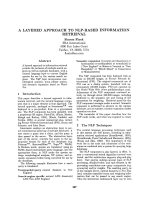Báo cáo khoa học: "A LOGICAL APPROACH TO ARABIC PHONOLOGY" ppt
Bạn đang xem bản rút gọn của tài liệu. Xem và tải ngay bản đầy đủ của tài liệu tại đây (573.26 KB, 6 trang )
A LOGICAL APPROACH TO !ARABIC PHONOLOGY
Steven Bird & Patrick Blackburn
University of Edinburgh, Centre for Cognitive Science
2 Buccleuch Place, Edinburgh EH8 9LW, Scotland
steven@cogs ci. ed.
ac. uk, patrick@cogsci, ed. ae. uk
ABSTRACT
Logical approaches to linguistic description, particu-
larly those which employ feature structures, have generally
treated phonology as though it was the same as orthography.
This approach breaks down for languages where the phono-
logical shape of a morpheme can be heavily dependent on
the phonological shape of another, as is the case in Ara-
bic. In this paper we show how the tense logical approach
investigated by Blackburn (1989) can be used to encode
hierarchical and temporal phonological information of the
kind explored by Bird (1990). Then we show how some
Arabic morphemes may be represented and combined t .
INTRODUCTION
There is an increasingly widespread view that linguis-
tic behaviour results from the complex interaction of mul-
tiple sources of partial information. This is exemplified
by the rapidly growing body of work on natural language
syntax and semantics such as the Unification-Based Gram-
mar Formalisms. Similarly, in phonology there is a popular
view of phonological representations as having the same
topology as a spiral-bound notebook, where segments (or
slots) axe strung out along the spine and each page gives a
structural description of that suing according to some de-
scriptive vocabulary. Crucially only those segmental strings
which are licensed by all of the independent descriptions
are acceptable.
The practical difficulty is tO come up with a model of
grammatical organization which allows the right informa-
tion to be brought to bear at the right stage. One model
which looks particularly attractive in this regard considers
the traditional modules of grammar
(i.e.
syntax, seman-
tics and phonology) not in
series
where the output of one
feeds into the input of the next, but rather in
parallel,
where
each module exerts independent constraints. For example, a
morpheme may be represented as a complex consisting of a
semantic expression, a constraint on (morpho)syntactic dis-
tribution, and a phonological description. The combination
of morphemes is then subject to three independent calculi,
one per domain. The result is a compositional account of
the relationship between form and meaning, as evidenced
in the work of Bach (1983), Hoeksema & Janda (1988)
and Wheeler (1988). However, all these proposals have as-
sumed that phonological representations are merely linear
I We are indebted to Mike Reape, Ewan Klein and members
of the Edinburgh Applied Logic group for discussions of the ma-
terial presented here. We are grateful for the support of ESPRIT
Basic Research Action 3175 (DYANA) and SERC post-doctoral
fellowship B/ITF/255.
sequences of segments. Such a restriction renders a theory
incapable of expressing the observations which have been
made in the non-linear phonology literature (e.g. Goldsmith
1990). Bird & Klein (1990) and Bird (1990) have endeav-
oured m show how the compositional approach can be lib-
erated from a purely linear segmental view of phonology.
This paper exemplifies and extends those proposals.
The first section presents a logical language for phono-
logical description. The second section shows how it has
sufficient expressive power to encompass a variety of obser-
vations about syllable structure. The final section discusses
further observations which can be made about Arabic syl-
lable structure, and provides an illustrative treatment of so-
called non-concatenative morphology in the perfect tense
'verb paradigm.
LOGICAL FRAMEWORK
Interval based tense logics are calculi of temporal rea-
soning in which propositions are assigned truth values over
extended periods of time s. Three operators F (future), P
(past) and O (overlaps) are introduced: F~b means "q~ will
be the case (at least once)", P~b means "~b was the case (at
least once)" and O~b means "~b is the case at some over-
lapping interval (at least once)". O corresponds to what
phonologists call 'association'. Typically sentences are true
at some intervals and not at others. (This is obviously the
case, for example, if ~b encodes the proposition "the sun
is shining".) Blackburn (1989) has explored the effects of
adding of a new type of symbol, called
nominals, to
tense
logic. Unlike ordinary propositions, nominals are only ever
true once. In a sense, a nominal is a 'name' (or a 'tem-
poral indexical') for that unique period of time at which it
is true. Certain observations about time can only be ex-
pressed in a theory which employs nominals. For example,
i ~ -~Fi
picks out precisely the irreflexive time flows,
whereas no formula containing only propositional variables
can do this. Nominals have been employed in the analysis
of temporal reference in linguistic semantics. The present
paper illustrates an application of nominals to a very differ-
ent domain, namely phonology. In addition to F, P and O,
we shall employ the modality O to represent phonological
dominance a.
2 See van Benthem 1983 for an introduction to this field and a
survey of a variety of possible formulations of temporal structure.
3 The notion of dominance as eanployed in phonology corre-
sponds closely to the use of the term in feature logics. However.
we treat dominance as a relation rather than as a collection of par-
tial functions, for two reasons. First. in phonological structures, it
is the nodes and not the arcs which are labelled. Second, there can
be multiple arcs emanating from a node.
- 89 -
Syntax. Let X = {p, q, r, } be the propositional vari-
ables and let N = {i, j, k, } be the nominals of L. Then
L is the smallest set such that all of the following hold,
where ¢, ~P E L.
T,_k E L X,N C L
<>~b,F¢,P¢,O¢ E L ~b v ¢,-~¢ E L
We define , , , and A as usual. We also define the duals
of our modal operators in the usual fashion: G~b - ~F~¢
(~b is always going to be the case), H~b = -~P ,¢ (~b always
has been the case), C~b ~. ~O ,q~ (~b holds at all overlap-
ping intervals) and El~b ~ ~O~b (~b is true at all 'daughter'
intervals). Two additional defined operators will play an im-
portant role in what follows: Me = P~b V O~b V F~b, and
its dual L¢ ~_ ~M~¢. It follows from the semi-linear time
semantics adopted below that M~b means '~b holds at some
time' and L~b means '~b holds at all times'. We will often
abbreviate <>(p A ~b) using the expression (p)~b and abbre-
viate a sequence of such applications (Pl)'" (p,,)~b using
the expression {pl"" "p,)¢. We adopt a similar practice
for the dual forms: [p]$ is shorthand for r3(p : ¢) and
[Pl " "P,,]$ is shorthand for [Pa]'" [P,,]¢. We also write
<)n (or t3") to stand for a length n sequence of 0s (or 13s).
Semantics. Let T be a set of intervals (which we will think
of as nodes), and let ~, < and e be binary relations on T.
As < models temporal precedence, it must be irreflexive
and transitive, o models temporal overlap (phonological
association), and so it is reflexive and symmetric. < and
o interact as follows: (i) they are disjoint, (ii) for any tl,
t2, t3, t4 G T, tl < t2 o t3 < t4 implies tl < t4 (that is,
precedence is transitive through overlap), and (iii) for any
t~, t2 E T, tl < t2 orhot2 orb > t2 (thatis, our concep-
tion of time is semi-linear). Note that the triple (T, <, o)
is what temporal logicians call an interval structure.
The remaining relation ~ encodes the hierarchical or-
ganization of phonological structures. As a phonological
unit overlaps all of its constituents (cf. Hayes 1990:44), we
demand that the transitive closure of 8 be contained within
o. Furthermore, phonological structures are never cyclic
and so we require that for any h , . . . , t, ~ T, if h tt~
tn-l~tn then it is not the case that t,,btl. By a phonolog-
ical frame F we mean a quadruple (T, <, o, B}:of the type
just described.
It merely remains to link L with such structures. A
valuation V is a function (X t3 N) * 2 T that obeys three
constraints. First, it must assign a singleton set to each
nominal. Second, for each t E T, there is an i 6 N such
that V(i) = {t}. Third, fib,t2 ~ V(p) wherep ~ X
then tl o tu * t~ = t2. In short, valuations are functions
which ensure nominals act as: names, where all intervals
are named, and valuations capture the idea that phonological
'tiers' are linearly ordered. A model for L is a pair (F, V).
Satisfaction. Let M = (F, V):, t E T, a ~ X O N. Then:
M b, " iff t e V(a) M b, ,~b iff M ~: ~b
M ~, ¢ V 'C, iff M ~t ¢ or'M ~, ¢2 :
M ~, O¢ iff qt' :
tSt' and M ~,, ¢
M~, O~biffgt':tot' andM~,,~b
M~, F¢ iffSt' : t < t' and M ~,, 4~
M~,P~biffgt':t'<tandM~,,~b
If 9*( ~, ¢ then we say that ~b is true in M at :t. Note that
under this semantics, M really does mean 'at some time'
and L means 'at all times' (by virtue of semi-linearity).
Validities. If (F, '12) ~t ~b for all frames F, for all valua-
tions V on F, and all t E T, then we say ff is a validity.
The following are some examples of validities. The first
group concerns our intervalic structure.
(TI) i , ,Fi. Precedence is irreflexive.
(T2) ~b ~ O~b. Overlap is reflexive.
(T3) ~ ~ C0¢. Overlap is symmetric.
(T4) Fi ,-~Oi. Pi ,-~Oi.
Precedence and overlap are disjoint.
(TS) FOFqS F¢.
Precedence is transitive through overlap.
(T6) F~AF¢ ~ F(¢^F¢)vF(~bAF¢)vF{¢AO~b).
Time is semi-linear 4 .
The next two validities concern the dominance relation and
its interaction with the interval structure.
(D1) 0'*¢ ~ O~b. The transitive closure of dominance is
included in the overlap relation.
(D2) i * -~O'* i. Dominance is acyclic.
The next group of validities reflect the constraints we have
placed on valuations.
(FORCE) Mi.
Each nominal names at least one interval.
(NOM) i A M(i
A
¢)
¢.
Each nominal names at most one interval.
(PLIN) p A O(p ^ ¢) * ~.
Phonological tiers are linearly ordered.
Proof Theory. It is straightforward using techniques dis-
cussed in (Gargov et al. 1987, 1989, Blackburn 1990) to
provide a proof theory and obtain decidability results. At
present we are investigating efficient proof methods for this
logic and hope to implement a theorem prover.
EXPRESSING
PHONOLOGICAL CONSTRAINTS
Feature
Matrices. L can be used for describing feature
matrices. For example, consider the matrix below.
[ PHON (Kay, pats, Blackle) ]
A possible description of this matrix is: (PHON)(Kay A
Fi)
A (PHON)(pats A i A
F j)
A (PHON)(Blackie A j). This
representation of sequences (cf. Rounds & Manaster-Ramer
1987) enables the expression of partial ordering constraints
which are widely required in phonological descriptions. Note
that all instances of the following variant of the NOM schema
are valid. E and E' are strings of modal operators from
{<>, F, P,O}.
(NOME)
Ei A E'(i ^ ¢) , E(i
A ¢) A
E'i.
Formulas may be transferred between different p~hs
to the same interval.
4The mirror image of this formula, obtained by replacing all
Fs with Ps, is also valid.
- 90 -
This schema expresses a familiar equivalence on feature
matrices. For example:
[,,,,o, [
[]
That is, nominals may be used in the representation of reen-
trancy (Bird 1991),
Sort Lattices. Node labels in phonologists' diagrams (e.g.
see example (1)) can be thought of as classifications. For
example, we can think of p E X as denoting a certain
class of nodes in a phonological structure (the mora nodes).
Moras may be further classified into onset moras and coda
moras, which are written as Po and/~c respectively. The
relationship between /~, Po and Pc can then be expressed
using the following formulas:
L(p po
v
pc) L(po
A pc i)
Such constraints are Boolean constraints. For example, a
simple Boolean lattice validating the two formulas con-
cerning moras above is ( {p, #o, #c, _L} ; po I-1 pc = .L,
po LJ pc = # ). This is depicted as a diagram as follows:
~o G
3.
Each element of X appears as a node in the diagram. The
join (U) of two sorts p and q is the unique sort found by
following lines upwards from p and q until they first con-
nect, and conversely for the meet (I-1). For convenience,
constraints on node classifications will be depicted using
lattice diagrams of the above form. Trading on the fact that
L contains propositional calculus, Boolean constraints can
be uniformly expressed in L as follows:
(i) p I-I q = r becomes L(p A q ~ r)
(ii) p
U
q = r becomes L(p
V
q r)
Appropriateness Constraints. As we shall see, the hi-
erarchical prosodic structures of phonology are highly con-
strained. For example, syllables dominate moras and not the
other way around, and so a structure where there is a mora
dominating a syllable is ill-formed. Following (Bird 1990),
we express these restrictions on dominance by augmenting
the sort lattice with a binary' 'appropriateness' relation A,
represented graphically using arrows. We can express in
L the constraints captured by such appropriateness graphs.
For example, L(p , -~Oq) expresses the fact that a node
with sort p cannot dominate a node with sort q. We can
also use L to express stronger ¢o~traints. For example,
L(p Oq) expresses the fact that a node of sort p must
dominate at least one node of sort q. In short, the O oper-
ator allows us to express graphical constraints.
A THEORY OF PHONOLOGY
A phonological theory is a collection of generalizations
expressed in a language of the above logic. We choose as
our language X = tr, O'h, ell, ao, trc, (rho, ~rhc, alo, ale, p,
/to, Pc, 7r, Xc, xv, b, d, h, J, k, n, r, s, t, w, ?, a, u, I. The
nine tr symbols are for the classification of syllables into
heavy vs. light and open vs. closed and their various cross
classifications. We have already been introduced to p, Po
and pc, for moras, onsets and codas respectively. The re-
maining symbols are classifications of segments (x), firstly
into vowels Orv) vs. consonants (xc), and then into the
individual segments themselves (in boldface). This classi-
fication is depicted in (2) below.
Syllable Structure. Phonological representations for sta,
tat, taat and ast are given in (1) 5.
(1) a. o b. o c. o d. o
P- g lilt I.tg
/Ix, A Ik
sta tat tat ast
We can describe these pictures using formulas from L. For
example, (lc) is described by the formula:
# ^ (#)(Fj ^ (Tr)t A 0r)(a A i)) ^ (p)(j ^ (x)i ^ 0r)t)
It is possible to use formulas from L to describe ill-formed
syllable structures. We shall rule these out by stating in L
our empirical generalizations. We begin by specifying (i)
the relationship between the sorts (i.e. the set X) using a
sort lattice and (fi) how the sorts interact with dominance
using an appropriateness relation. We then express in L the
constraints graphically represented in the appropriateness
graph in (2).
(2) T
aLo~l~°ho~b k . t ? w a u
i
L
The arrows may be glossed as follows: (i) all syl-
lables
must dominate an onset more~ (ii) heavy syllables
must dominate a coda mora and (iii) all moras must dom-
inate a segmenL The fact that potential arrows are absent
also encodes constraints. For example: (i) syllables, moras
and segments alike cannot dominate syllables and (ii) light
syllables do not have coda moras. Constraints concern-
ing the number of nodes of sort p that a node of sort q can
dominate, and constraints concerning temporal organization
cannot be stated in this graphical style. Nevertheless, they
can be expressed in L as follows.
(AI) L((po)/p
~
[po]~b). Onsets are unique.
SSe¢ (Bird 1990) for arguments justifying this view of syllable
structure. Moras are traditionally employed in the representation of
syllable weight: a syllable with two moras is heavy, and a syllable
with one mora is
light.
_ 91 .
(A2) L((#c)~ ~ [#club). Codas are unique.
("177) L( (pc)qb ~ (#o)F~). Onsets precede codas.
(T8) L(ao -~
(#, ~rv)/p A [#,
rc]F~).
An open syllable ends with a vowel.
(T9) LCa ~ -,((p, 7rv)F~
A (~, lrc)(~ A F~b) A (#, ~rv)~b)).
The vowels of a syllable must form an unbroken se-
quence.
(T10) L(o" h * ",(po)((~vv)F~ A (~c)~)).
In a heavy syllable, the onset cannot end with a con-
sonant.
We can express the constraint that two syllables cannot
share a mora as follows.
(A3) L(i Acr A (p)j ~ -~M("~i A (#)j)).
Two syllables cannot share a mora.
An interesting alternative is to add an operator <>-1 that
looks backwards along the dominance relationS.: The con-
straint that two syllables cannot share a mora could then
be written L(# A ((r)-l~b , [cr]-l~b). There are further
phonological phenomena which suggest that this may be an
interesting extension of L to explore. For example, the re-
quirement that all moras and segments must be linked to the
hierarchical structure (prosodic licensing) may be expressed
thus: L((# v
7r) ~ O-IT).
Partiality. Crucially for the analysis of Arabic, it is pos-
sible to have a formula which describes more than one di-
agram. Consider the formula M(a A (#, x)(tA Fi)) A
M(trA (th ~r)(aA i)), which may be glossed 'there is a syl-
lable which dominates a t, and a syllable which dominates
an a, and the t is before the a'. :This formula describes the
three diagrams in (3) equally well:
(3) a. o b. o e. o o
I
II
l.t It It Itit
A II II
t a t a ; t a
If a level of hierarchical structure higher than the sylla-
ble was employed, then it would not be necessary to use
the M operator and we could write: (tr, #, x).(t A Fi) A
(a,
#,
7r)(a
A i).
ARABIC VERB MORPHOLOGY
In the Semitic languages,: individual morphemes are
often not manifested as contigl!ous strings of segments. A
morphologically complex form must be expressed as the
• intercalation of its component morphemes. An example
of this phenomena is illustrated in Figure 1 for the per-
fective active r. Consider the form kattab in the second
row. Its particular arrangement of four consonants and two
e
That is, O-1 is to O as P is to F.
7 Note that these are uninflected forms. Some forms are actu-
ally non-existent (for semantic reasons); these are i~dicated by a
dash. However, this is unimportant since the present interest is in
phonological structure and in potential forms.
Conj Verb Form Gloss
I katab wrote
II kattab caused to write
HI kaatab corresponded
IV _?aktab dictated
V takattab
VI takaatab kept up a correspondence
VII _nkatab subscribed
VIII k tatab copied
IX ktabab
X staktab had a copy made
XI ktaabab
XII ktawtab
XIII kta_w_wab
XIV ktanbab
XV kta~_bay
II dai3.ra j rolled
V _tadal3ra j caused to roll
XI .d.harjaj
XIV d.hm3ra j
Figure 1: Arable Data based on (McCarthy 1981)
vowels identifies it with the second conjugation. Certain
forms have additional affixes which are underlined in the
above table. In what follows, we make a number of ob-
servations about the patterning of consonants in the above
forms, showing how these observations can be stated in L.
Arabic Syl'lable Structure. It is now widely recognized
amongst phonologlsts that an analysis of Arabic phonology
must pay close attention to syllable structure s . From the
range of syllabic structure possibilities we saw in (1), only
the following three kinds are permitted in Arabic.
(4) a. C
b. C
c.
It. It It }.t It
A N /11
t a: t a t a t
The following "generalizations can be made about Arabic
syllable structutre.
(A4) L(ac * ~rh). Closed syllables are heavy.
There is a maximum of one consonant per node.
(A6) L((xv)~ [xv]~).
There is a maximum of one vowel per node.
(AT) L0,~ ^ (~)~ -, [~]~).
There is a maximum of one segment per coda.
(AS)
~((~, ,~v)q, -, b,, ,,-v],/,).
There is a maximum of one vowel per syllable,
SThe approadaes to Arabic phonology presented by Kay (1987)
and Gibbon (1990) while addressing important computational
issues fail to represent the hierarchical organization of
phono-
logical
structures.
- 92 -
(Tll)
L(t,o -" (rc)F¢
A (rv)~b).
Onsets must have a consonant and a vowel, in that
order.
There are certain phonological phenomena which appear to
move us beyond the bounds of L: the need to specify de-
faults. Phonologists often employ default consonants and
vowels, which appear when the consonant or vowel posi-
tions in syllable structures have not been filled. In Arabic,
the default consonant is ? (the glottal stop) and the default
vowel is a. The default consonant only appears word ini-
tially. There are two ways we can treat such defaults. First,
we can regard them as instructions on how one ought to
'compute' with L. That is, we regard them as instructions
to attempt to build certain preferred models. Alternatively,
we could combine L with a default logic.
MORPHOLOGICAL COMBINATION
Consider the forms kattab and dahraJ. Both consist of
two closed syllables. This observation is expressed below.
(II)
M(ac A i A Fj) A M(ac A j) A L(a ~ iV j)
Similarly, the two consonantisms can be represented as fol-
lows. (Note that il, i2 and iz are introduced in the (KTB)
lbrmula as labels of syllable nodes; these labels will be
referred to in the subsequent discussion.)
(KTB) M(a A i, A (~, r)(k A k, A Fk2))
A
M(a
A i: A (#, r)(t A k2 A Fka))
A i(~ A is A (#, ~)(b A k3))
(DHRJ)
M(aA(/~,Tr)(dAkl
AFk2))
A M(a A
(t~,
7r)(h. A k2 A Fks))
^ M(~ ^ (~, ,0(r ^ ks ^ Fk,))
^ U(~ ^ (#, ,~)(j ^ k,))
To derive kattab, we simply form 0I) ^ (KTB). The final
conjunct of (H) requires that there be only two syllables.
Consequently, each syllable mentioned in (KTB) has to be
identified with i or j. There are eight possibilities, which
fall into three groups. In what follows, i ~ j is shorthand
for
L(i * , j),
i.e. L is rich enough to support a form of
equational reasoning 9.
(i) il ,~ i2 ~ is ~ i or il ~, i2 ,.~ is ~ j. This would
require a syllable to dominate three distinct conso-
nants. However, fxom (A1), (A2) and (A5), Arabic
syllables contain a maximum of two consonants.
(ii) i~,.~is~i,i2~j;i2~i3~i,i~j;i2~i, il
i3 ,~ j; or is ~ i, il .~ i2 ,~ j. In
all
of these
cases, we have the following
reductio ad absurdum,
for some k' E {kl, k2, ks}.
M(~, ^ 0', ~¢)k' ^ Fj) ^ M(,, ^ j ^ (#, ~aFk')
M(Ok' A Fj) A M(j ^ OFk')
(D1)
M(Ok'
A
FOFk') (NOM)
M(Ok'
A Fk')
(T5)
M(Ok' ^ -',Ok')
(T4)
!
9Other useful 'macros' are i -~ j, which expands to
L(i +
Fj). and ; o j, which expands to L(i -40
j).
(iii) il ~ i2 ~ i, i3 ~ j or ix ~ i, i2 ~ i3 ~ 3. It
follows from the above default stipulations that two
of the four consonants of (It) must be identical. By
a similar process to that used in (ii) above, we can
show that the coda consonant of i is identical to the
onset consonant of j. The result is shown in (5a).
(5)
a. a a b. a a
A A A A
AVe\ A\A\
k ~v t gv b d ~
v
h r n v J
The case of (II) A (DHRJ) is depicted in (5b). The four con-
sonants of (DHRJ) satisfy the requirements of the second
conjugation template (II) without the need for reentrancy.
OTHER PHENOMENA
Consonant Doubling.
In conjugations IX, XI, XII, XIV
and QIV there is a non-geminate doubling of consonants.
In the exceedingly rare XH, the second consonant (t) is dou-
bled. In all the ;other cases, the final consonant is doubled.
The most direct solution is to posit a
lexical rule
which
fIecly applies to consonantisms, doubling their final con-
sonant. For example, the rule would take the (KTB) form
provided above and produce:
(KTB')
M((I~, ~r)AkAFkl))AM((#,
7r)AtAkl AFk2))
AM((#;rc) AbAk2AFk3))AM((#,
rr) A bA k3))
It would be necessary to prevent this extended form from
being used in conjugations 17 and V. since the patterns
katbab and takatbab are unattested.
The Reflexive Affix. Conjugations V, VI and VIII are
marked by the.presence of a reflexive affix t. Rather than
viewing these conjugations as basic (as Figure 1 implies),
we can treat them as having been derived from conjuga-
tions H, IN and I respectively. As this affix always ap-
pears as the onset of a light syllable, we shall represent it
thus:
M(ct I
A (/z, a')t). This morpheme will actually be
expressed lexically as a function from conjugations to con-
jugations which attaches a syllable of the above form to
the existing phonological material of a conjugation. The
affix must be ordered relative to the other syllables. A con-
straint encoding the observation that all conjugations end
in a closed syllable would prevent the affix from being a
suffix. The fact that the affix is a
light
syllable correctly
rules out ktattab (V) and ktaatab (VI), leaving only the at-
tested forms for (V) and (VI). A constraint which prevented
the first two syllables of a conjugation both being light (cf.
McCarthy 1981:387), easily expressed in L, would rule out
takatab (VIII) leaving only the attested form for (VIII).
Extrametricality. Above we specified conjugation H as
having a closed final syllable. Looking back at Figure 1, it
would appear as if all conjugations end in a closed syllable.
However, a study of the inflected forms reveals that this
is not the case. For example, the third person plural of
kattab is kattabu. From (Tll), the b must be syllabified
with the vowel to its
right.
However, the first person plural
- 93 -
is kattabna, and the b is syllabified with the vowel to its
left.
Similarly, the s of staktab is not part of the syllable
tak. It is actually the coda of a previous syllable. In order
to pronounce this form, ?i is prefixed, producing ?istaktab.
Therefore, the conjugations are not merely sequences
of complete syllable templates, but rather they are sequences
bounded by unsyllabified (or
extrametrical)
consonants. The
definition of lI should therefore be modified to be
Mac A
M(~¢ A (/~o)) A M(@ A (/~)) 10. This is intended to leave
open the possibility for the final consonant to be syllab-
ified with the second syllable
or
with the third syllable,
while simultaneously requiring it to ultimately be syllabi-
fled somewhere.
CONCLUSION
In this article we have presented an application of inter-
val based tense logic to 'non-linear' phonology (specifically,
'autosegmental' phonology, Goldsmith 1990), and exempli-
fied it using data from Arabic (McCarthy 1981). The chief
difference between this view of phonology and its purely
segmental predecessors is its use of overlapping intervals
of time.
As argued in (Bh'd 1990), the three primitives: dom-
inance, precedence and overlap are sufficient to represent
hierarchically and temporally organized phonological struc-
ture. Here we have taken a standard language of interval
based tense logic, augmented it with an extra operator <> to
express phonological dominance, and employed nominals
to enable us to label nodes. A universal theory of syllable
structure was expressed in L, to which further generaliza-
tions were added for Arabic. We then showed how so-called
'non-concatenative' morphology might be treated, and in-
dicated how the phonological notions of extramela'icality
and licensing were cashed out. The analysis of Arabic did
not require recourse to separate consonant and vowel tiers
(following Hudson 1986). Rather, consonantisms (and vo-
calisms) are simply partially specified phonological struc-
tures which may be combined using logical conjunction.
Even so, the exemplification given was for but a tiny frag-
ment of Arabic phonology and much work is still to be
done. For example, nothing was said about the vocalisms.
The move from linear to non-linear phonology paral-
lels the move from a purely Priorean tense logic in F and
P to interval based systems in F, P and O. The view of
phonology emerging from the present study is significantly
more formal than many of its contemporaries (eL Bird &
Ladd 1991), and suggests that enhanced modal formalisms
may provide a natural foundation for rigorous phonological
theorizing.
Finally, there would seem to be good reasons for being
confident that complex phonological descriptions can now
be fully incorporated into feature structure based grammar
frameworks. Reape's (1991) logical foundation for these
frameworks and the phonological arguments in favour of
adopting feature structures (Hayes 1990, Bird 1991) are but
two parts of the one story.
10Note that the exhaustiveness condition
L(a ~ i V j)
and
the sequencing constraints in the earlier version of (I1) must be
expressed here also. They are omitted for the.sake of readability.
REFERENCES
Bach, E. (1983). On the relationship between word-grammar
and phrase-grammar.
Natural Language and Linguistic The-
ory 1, 65 89.
van Benthem, J. (1983).
The Logic of Time.
Dordrecht:
Reidel.
Bird, S. (1990).
Constraint-Based Phonology.
Ph.D. The-
sis. Edinburgh University.
Bird, S. (1991). Feature structures and indices.
Phonology
8(1).
Bird, S. & E. Klein. (1990). Phonological Events.
Journal
of Linguistics
26, 33-56.
Bird, S. & D. R. Ladd. (1991). Presenting Autosegmental
Phonology.
Journal of Linguistics
27(1).
Blackburn, P. (1989).
Nominal Tense Logic.
Edinburgh
University. CCS/RP-40. To appear in P. Petkov (ed.)
Pro-
ceedings of the Kleene '90 Conference.
Springer.
Blackburn, P. (1990).
Nominal Tense Logic and other Sorted
Intensional Frameworks.
Ph.D. Thesis. Edinburgh Univer-
sity.
Gargov, G., S. Passy & T. Tinchev. (1987). Modal en-
vironment for Boolean speculations. In D. Skordev (ed.)
Mathematical Logic and its Applications.
Plenum Press.
Gurgov, G. & V. Goranko. (1989).
Modal Logic with
Names l.
To appear. Bulgarian Academy of Sciences.
Gibbon, D. (1990). Prosodic association by template inher-
itance.
International Workshop on Inheritance and Natural
Language Processing.
Tilburg.
Goldsmith, J. (1990).
Autosegmeraal and Metrical Phonol-
ogy. Oxford: Blackwell.
Hayes, B. (1990). Diphthongization and coindexing.
Phonol-
ogy 7, 31-71.
Hoeksema, J. and R. Janda. (1988). Implications of process
morphology for categorial grammar. In Oehrle et al.
Hudson, G. (1986). Arabic root and pattern morphology
without tiers.
Journal of Linguist&s
22, 85-122.
Kay, Martin. (1987). Nonconcatenative finite-state mor-
phology.
Proceedings of the 3rd EACL.
2-10.
McCarthy, J. (1981). A prosodic theory of nonconeatena-
five morphology.
Linguistic Inquiry
12, 373 413.
Oehrle, R., E. Bach & D. Wheeler. (eds.) (1988).
Catego-
rial Grammars and Natural Language Structures.
Reidel.
Reape, M. (1991).
A Formal Theory ofWord Order: A Case
Study in Germanic.
Ph.D. Thesis. Edinburgh University.
Rounds, W. & A. Manaster-Ramer. (1987). A logical ver-
sion of functional grammar.
Proceedings of the 25th Annual
Meeting of the ACL.
89-96.
Wheeler, D. (1988). Consequences of some categorially
motivated phonological assumptions. In Oehrle et al.
- 94 -
